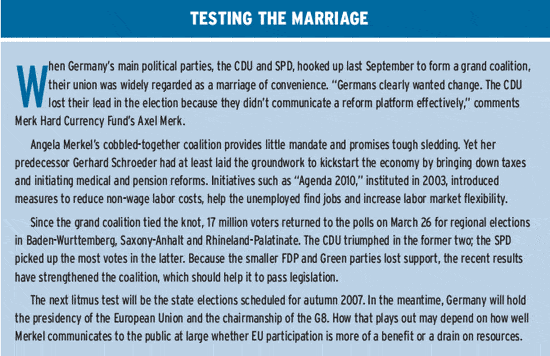TURNING POINT

A few months ago, reeling from an inconclusive general election, Germany was facing an uncertain future. Undaunted, the countrys new chancellor, Angela Merkel, tried to rally enthusiasm and optimism with her promise to get Germany back on its feet.
On the face of it, it now appears her confidence was justified as signs of economic resurgence are sprouting on all sides. In their spring survey, the economic institutes of Kiel, Berlin, Hamburg, Munich, Halle and Essen revised their 2006 growth forecasts up from 1.2% to 1.8%. Investment in machinery and equipment has been expanding since 2004; manufacturing orders have risen since last year. Business confidence for manufacturing, wholesaling and construction all rose in April to the highest levels since unification in 1991.
Of course, these hopeful signs are still preliminary. Id hardly call 1.8% GDP a party, comments James Berman, president of global advisory firm JB Global in New York. He contrasts the upwardly revised growth estimates with the United States, which is growing at 3%, and even Japan, which appears poised to break through the 2% barrier. Skeptics are also concerned that much of the happier news is concentrated in forward-looking indicators, so the data will not be confirmed for a couple of quarters.
Doom-mongers point to some decidedly less speculative figures to back up their opposing views. Unemployment, for example, remains stubbornly high. Despite falling in April, unemployment levels remain at 11.5%, according to the governments Federal Labor Agency. Perhaps because of the persistently high level of unemployment, the government has also been playing down the six institutes rosy economic report, characterizing it as overly optimistic.
It is not entirely surprising that the government is leaning toward pessimism. Ever since it yielded its monetary policy to the European Central Bank, it has been compelled to rely on slower and blunter fiscal tools to control its domestic economy. And faced with a huge hole in its public finances, the new government is having to resort to one of the bluntest tools of alltax increasesto try to stem the flow of red ink. Unfortunately, raising taxes could easily nip the nascent economic recovery in the bud.
|
|||
|
|
|
|
Vanessa Drucker





